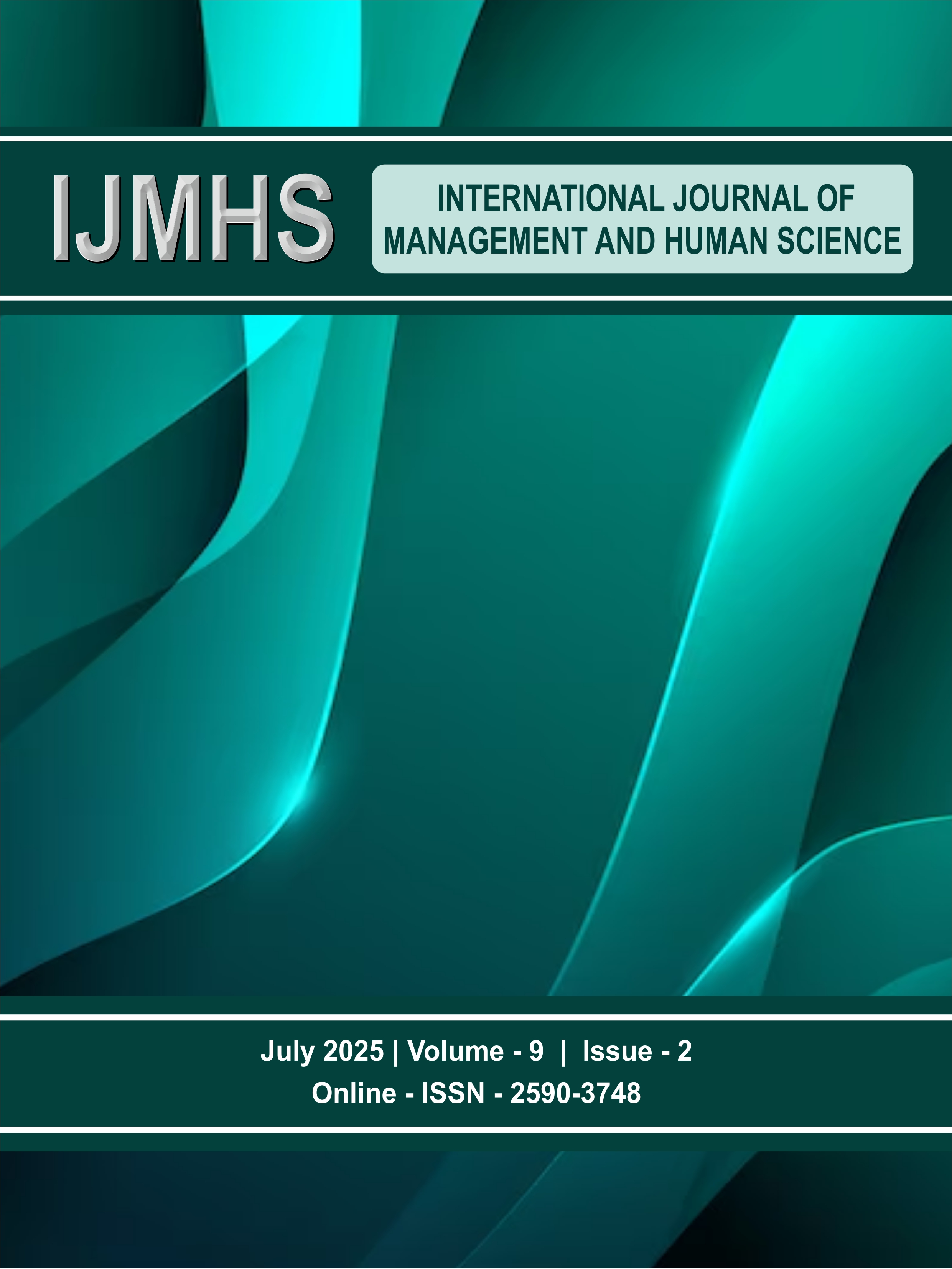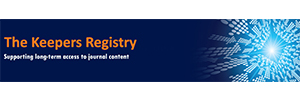Measuring the Volatility in Gold Prices of India during the Russia-Ukraine Crisis: Evidence from the TGARCH Model
DOI:
https://doi.org/10.31674/ijmhs.2025.v09i02.006Abstract
Background: The Russia-Ukraine conflict has significantly impacted global financial markets, particularly commodity prices, with gold being a key asset. In India, gold holds cultural and economic importance, amplifying its relevance during geopolitical crises. Objective: This study aims to analyse the volatility in gold prices in India during the Russia-Ukraine crisis, focusing on asymmetries in gold price returns and the long-memory effects of the crisis on these prices. Methods: Daily gold price data (in rupees per gram) from January 1, 2021, to October 28, 2023, were used, totalling 1030 observations. A dummy variable representing the conflict period was introduced. The Augmented Dickey-Fuller (ADF) unit root test was applied to check for stationarity, and the Threshold GARCH (T-GARCH) model was employed to assess volatility and leverage effects. Results: The analysis found significant volatility in gold prices during the crisis. The T-GARCH model showed a leverage effect, with negative returns influencing future volatility more than positive returns. Unit root tests confirmed stationarity in the gold price series after the first difference. Conclusion: The study demonstrates that geopolitical crises like the Russia-Ukraine conflict contribute to volatility clustering in gold prices. The results emphasise the role of gold as a safe-haven asset, providing valuable insights for investors and policymakers, particularly in countries like India, where gold is culturally and economically significant.
Keywords:
Asymmetries, Gold Price, Russia-Ukraine Crisis, VolatilityDownloads
References
Agrawal, S., & Rao, V. (2023). Investor Behaviour during Crisis towards Different Investment Alternatives. Reimagining Management in the post VUCA World, 413.
Bagchi, B. (2015). A long-run and short-run cointegration model explaining relationship between liquidity management and profitability. International Journal of Business Excellence, 8(2), 123-145. https://doi.org/10.1504/IJBEX.2015.068204
Bagchi, B. (2016). Volatility spillovers between exchange rates and Indian stock markets in the post-recession period: An APARCH approach. International Journal of Monetary Economics and Finance, 9(3), 225-244. https://doi.org/10.1504/IJMEF.2016.078395v
Bagchi, B., & Paul, B. (2023). Effects of crude oil price shocks on stock markets and currency exchange rates in the context of Russia-Ukraine conflict: Evidence from G7 countries. Journal of Risk and Financial Management, 16(2), 64. https://doi.org/10.3390/jrfm16020064
Bagchi, B., Chatterjee, S., Ghosh, R., & Dandapat, D. (2020). Impact of COVID-19 on global economy. In Coronavirus Outbreak and the Great Lockdown: Impact on Oil Prices and Major Stock Markets Across the Globe (pp. 15-26). Singapore: Springer Singapore. https://doi.org/10.1007/978-981-15-7782-6_3
Barai, D., & Samal, G. P. (2025). Volatility Behaviour and Spillover Effect: Evidence from Indian Foreign Exchange Market. Global Business Review, 09721509251379836. https://doi.org/10.1177/09721509251379836
Bhattacharjee, A., Gaur, D., & Gupta, K. (2024). Russia–Ukraine war and the impact on Indian economy. Journal of Economic Studies, 51(4), 841-858. https://doi.org/10.1108/JES-03-2023-0136?urlappend=%3Futm_source%3Dresearchgate
Bhattacharyay, N., Ghosh, R., & Mukherjee, S. (2022). Understanding Regime-Switching Behaviour of Gold Price during Russia - Ukraine Crisis: Evidence from India. In Recent Advances in Management & Social Sciences, National Press Associates.
Bollerslev, T. (1987). A conditionally heteroskedastic time series model for speculative prices and rates of return. The Review of Economics and Statistics, 542-547. https://doi.org/10.2307/1925546
Ding, D. (2011). Modeling of market volatility with APARCH model. Department of Mathematics, Uppsala University. https://www.diva-portal.org/smash/get/diva2:417608/FULLTEXT01.pdf
Iqbal, N., Bouri, E., Grebinevych, O., & Roubaud, D. (2023). Modelling extreme risk spillovers in the commodity markets around crisis periods including COVID19. Annals of Operations Research, 330(1), 305-334. https://doi.org/10.1007/s10479-022-04522-9
Jareño, F., Escribano, A., & Umar, Z. (2023). The impact of the COVID-19 outbreak on the connectedness of the BRICS’s term structure. Humanities and Social Sciences Communications, 10(1), 1-12. https://doi.org/10.1057/s41599-022-01500-1
Naeem, M. A., Pham, L., Senthilkumar, A., & Karim, S. (2022). Oil shocks and BRIC markets: Evidence from extreme quantile approach. Energy Economics, 108, 105932. https://doi.org/10.1016/j.eneco.2022.105932
Pandey, D. K., Assaf, R., & Rai, V. K. (2023). Did the Indian stock market sail the Russia-Ukraine storm safely?. The Journal of Economic Asymmetries, 28, e00319. https://doi.org/10.1016/j.jeca.2023.e00319
Sahay, N., Gupta, N., & Rai, K. (2025). Volatility spillovers between exchange rates and stock markets in the BRICS economies: new evidence from COVID-19 and Russian Ukrainian war. International Journal of System Assurance Engineering and Management, 1-10. https://doi.org/10.1007/s13198-025-02722-7
United Nations. (2022, April 3). Ukraine: civilian casualty update 3 April 2022. United Nations Human Rights Office of the High Commissioner. https://www.ohchr.org/en/updates/2022/04/ukraine-civilian-casualty-update-3-april-2022#:~:text=Related&text=From%204%20a.m.%20on%2024,1%2C417%20killed%20and%202%2C038%20injured
United Nations. (2023, May 5). WHO chief declares end to COVID-19 as a global health emergency. UN News Global perspective Human stories. https://news.un.org/en/story/2023/05/1136367#:~:text=WHO%20chief%20declares%20end%20to%20COVID%2D19%20as%20a%20global%20health%20emergency,-5%20May%202023&text=The%20head%20of%20the%20UN,no%20longer%20a%20global%20threat
Wang, Y., Bouri, E., Fareed, Z., & Dai, Y. (2022). Geopolitical risk and the systemic risk in the commodity markets under the war in Ukraine. Finance Research Letters, 49, 103066. https://doi.org/10.1016/j.frl.2022.103066
Zakoian, J. M. (1994). Threshold heteroskedastic models. Journal of Economic Dynamics and Control, 18(5), 931-955. https://doi.org/10.1016/0165-1889(94)90039-6
Published
How to Cite
Issue
Section
License
Copyright (c) 2025 International Journal of Management and Human Science (IJMHS)

This work is licensed under a Creative Commons Attribution-NonCommercial-NoDerivatives 4.0 International License.
















